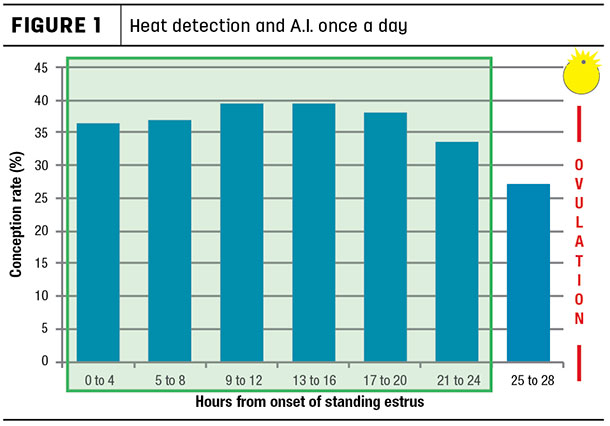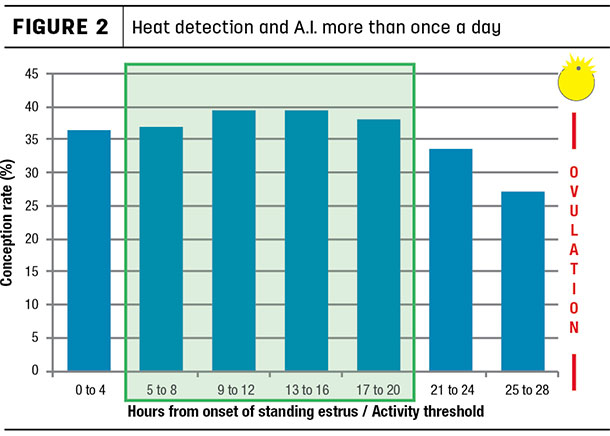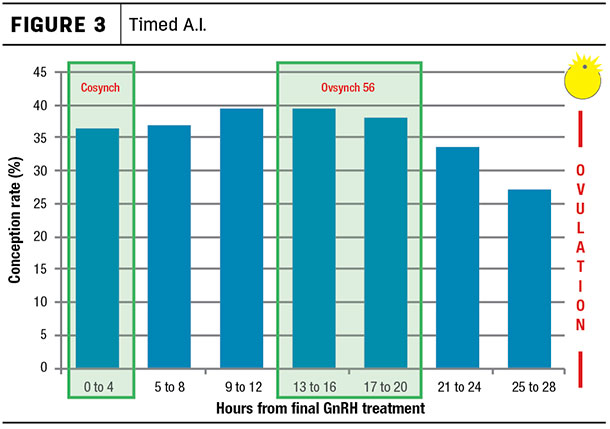Reproductive management is a game of averages. Different strategies for getting pregnancy established in dairy cows encompass a range of targets for timing artificial insemination (A.I.). Some are precise, aiming for the ideal timing. Others are broader and simply aim for an acceptable average. Most approaches result in pregnancies, but in some cases there remains opportunity for improvement and economical gain.
The exact timing of physiological events varies from cow to cow, but at a herd level we can use the decades of research to support or refute what should work. It has been clearly documented that the onset of estrus is one of the most reliable predictors for timing of ovulation. The average amount of time that elapses between the onset of estrus and ovulation is consistently around 28 hours, recognizing there is variability of several hours from cow to cow.
What is the optimal timing for A.I.?
If A.I. is performed too early, the lifespan of viable sperm cells in the female reproductive tract is challenged and fertilization may not occur. If A.I. is performed too late, embryo quality may be compromised because oocyte quality gradually deteriorates after ovulation. The optimal time for A.I. is 12 to 24 hours before ovulation, which correlates to four to 16 hours after the onset of standing estrus. This timing allows sperm cells to migrate and be prepared for fertilization, meeting a freshly ovulated oocyte at the right place and the right time.
What about the old ‘a.m.-p.m.’ rule?
For herds relying primarily on heat detection, the a.m.-p.m. rule of inseminating approximately 12 hours after estrus detection is still relevant, but it only works well if heat detection is occurring religiously at least three times per day (every eight hours). In many cases, breeding once a day can be just as successful.
Interestingly, the average interval to ovulation from the onset of standing estrus also matches the interval from when an activity threshold is exceeded as detected by an activity monitoring system or interval from GnRH injection. It is safe to expect all of these intervals to ovulation to be in the 24- to 28-hour range.
Activity monitoring systems monitor activity around the clock. Though they only capture secondary signs of estrus (increased activity, not actual standing estrus events), researchers have demonstrated that the average time to ovulation after a cow’s first standing event compared with the time to ovulation after the onset of increased activity differs by less than two hours. Therefore, using a similar approach as the a.m.-p.m. rule, inseminating approximately 12 hours after surpassing the threshold for increased activity is a sound strategy.
Optimal timing of insemination with different strategies
The following scenarios show how timing of insemination is addressed with different reproductive management strategies. Don’t be too distracted by the conception rates, which were adapted and extrapolated from a single research study. Rather, notice the bell-shaped curve that has proven repeatable across similar time spans in many research studies. Early insemination (around the onset of estrus) or late insemination (20-plus hours after the onset of estrus) results in compromised conception rates. The shaded boxes outline the times when insemination likely takes place under the different management systems.

With once a day heat detection and A.I., some cows will be inseminated at the time of optimum conception rates, but others inseminated at early or late time points will sacrifice a few percentage points. This approach may be efficient in terms of labor use and often results in acceptable conception rates, but the early and late inseminations will have a negative effect on the overall average.

Following the a.m.-p.m. rule or using activity monitoring systems can work well, with due diligence. Insemination of cows that have displayed reliable signs of estrus can be performed within a narrower time frame, when average conception rates are maximized.

Timed A.I. conveniently lessens the need for heat detection, while also requiring more management of time-critical synchronization treatments. Some of the most convenient protocols allow for the final GnRH treatment and A.I. to be performed at the same time (e.g., Cosynch 72). While convenient, this approach targets early A.I. and does not result in conception rates as high as can be achieved with a slightly more complicated protocol. It has become standard practice in many herds to follow the Ovsynch 56 protocol, which calls for GnRH treatment 16 hours before A.I., a more favorable time interval for maximizing conception rates.
If in doubt, it is better to inseminate early than late. Sperm cells are viable for a much longer period (about 24 hours) than ovulated oocytes (optimal fertility around six hours).
Regardless of your current protocols, don’t be afraid to take a look at timing of insemination and consider making a tweak. Newer, well-researched programs are often resulting in improved conception rates. A small change in conception rates can result in valuable gains for overall herd performance. ![]()
References omitted but are available upon request. Click here to email an editor.
PHOTO: Staff illustration.

-
Andrew Sandeen
- Penn State Extension – Indiana County
- Email Andrew Sandeen






